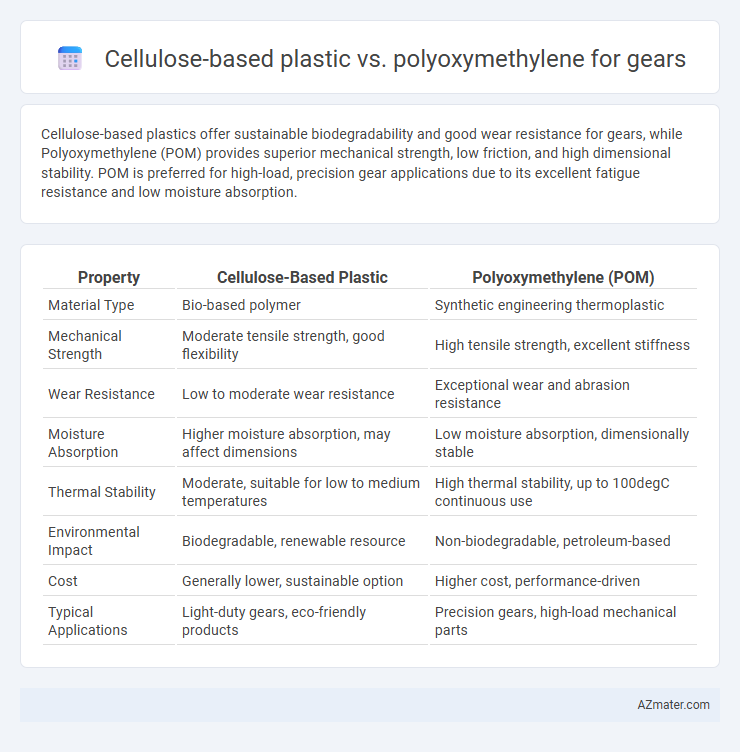Cellulose-based plastics offer sustainable biodegradability and good wear resistance for gears, while Polyoxymethylene (POM) provides superior mechanical strength, low friction, and high dimensional stability. POM is preferred for high-load, precision gear applications due to its excellent fatigue resistance and low moisture absorption.
Table of Comparison
| Property | Cellulose-Based Plastic | Polyoxymethylene (POM) |
|---|---|---|
| Material Type | Bio-based polymer | Synthetic engineering thermoplastic |
| Mechanical Strength | Moderate tensile strength, good flexibility | High tensile strength, excellent stiffness |
| Wear Resistance | Low to moderate wear resistance | Exceptional wear and abrasion resistance |
| Moisture Absorption | Higher moisture absorption, may affect dimensions | Low moisture absorption, dimensionally stable |
| Thermal Stability | Moderate, suitable for low to medium temperatures | High thermal stability, up to 100degC continuous use |
| Environmental Impact | Biodegradable, renewable resource | Non-biodegradable, petroleum-based |
| Cost | Generally lower, sustainable option | Higher cost, performance-driven |
| Typical Applications | Light-duty gears, eco-friendly products | Precision gears, high-load mechanical parts |
Introduction to Gear Materials
Cellulose-based plastics offer a sustainable alternative with good biodegradability and moderate mechanical strength for gear applications, while polyoxymethylene (POM) provides superior stiffness, low friction, and high dimensional stability critical for precision gears. The choice between these materials depends on factors such as load-bearing capacity, wear resistance, and environmental impact. Polyoxymethylene gears excel in high-performance machinery due to their excellent fatigue resistance, whereas cellulose-based plastic gears suit eco-friendly, low-load environments.
Overview of Cellulose-Based Plastics
Cellulose-based plastics, derived from renewable plant fibers, offer high biodegradability and low environmental impact compared to synthetic polymers like polyoxymethylene (POM). These bioplastics exhibit good mechanical strength and moderate moisture resistance but generally have lower heat resistance and durability than polyoxymethylene, which is known for its exceptional stiffness, low friction, and high dimensional stability in precision gear applications. The choice between cellulose-based plastics and POM depends on prioritizing sustainability and biodegradability versus superior mechanical performance and long-term wear resistance in gear manufacturing.
Key Properties of Polyoxymethylene (POM)
Polyoxymethylene (POM) stands out for its high mechanical strength, excellent dimensional stability, and superior wear resistance, making it ideal for high-precision gears. Its low friction coefficient and excellent fatigue resistance ensure long-term durability under cyclic loading conditions. Compared to cellulose-based plastics, POM offers enhanced chemical resistance and thermal stability, supporting better performance in demanding industrial applications.
Mechanical Performance Comparison
Cellulose-based plastics offer moderate tensile strength and excellent biodegradability, making them suitable for lightweight gears with lower mechanical stress. Polyoxymethylene (POM) demonstrates superior mechanical properties, including high stiffness, low friction, and excellent wear resistance, resulting in enhanced durability and load-bearing capacity for precision gears. The choice between cellulose-based plastics and POM depends on the balance between environmental sustainability and the stringent mechanical performance requirements of gear applications.
Wear Resistance and Durability
Cellulose-based plastics exhibit moderate wear resistance and are biodegradable, making them suitable for applications with lower mechanical stress. Polyoxymethylene (POM), known for its high crystallinity and low friction coefficient, offers superior wear resistance and durability, ideal for precision gears subjected to continuous operation. The enhanced dimensional stability and resistance to fatigue of POM ensure longer gear lifespan compared to cellulose-based alternatives.
Environmental Impact and Sustainability
Cellulose-based plastics offer significant environmental benefits for gear applications due to their biodegradability and renewable origin, reducing reliance on fossil fuels and minimizing plastic waste accumulation. Polyoxymethylene (POM), while providing excellent mechanical performance and durability, is derived from petrochemicals and is not readily biodegradable, contributing to long-term environmental persistence. Selecting cellulose-based plastics supports sustainability goals by promoting circular economy principles and reducing carbon footprint compared to POM's high environmental impact throughout production and disposal stages.
Cost-Effectiveness and Availability
Cellulose-based plastic offers a cost-effective alternative to polyoxymethylene (POM) for gear manufacturing due to its renewable sourcing and lower raw material costs, enhancing sustainability and reducing expenses. Polyoxymethylene, known for its high strength and precision, generally incurs higher production costs and depends on petrochemical sources, impacting long-term availability and price stability. Availability of cellulose-based plastics benefits from widespread biomass resources, whereas POM availability is subject to fluctuations in petrochemical markets, affecting supply consistency for gear production.
Machinability and Processing Differences
Cellulose-based plastics offer improved machinability due to their natural fiber reinforcement, resulting in easier cutting and reduced tool wear compared to Polyoxymethylene (POM), which requires more precision machining due to its homogeneous polymer structure. Processing cellulose-based plastics involves higher moisture sensitivity and requires controlled drying, whereas POM benefits from well-established injection molding techniques with less sensitivity to environmental conditions. The natural origin and biodegradability of cellulose-based plastics also contribute to differences in processing parameters like lower melting points and thermal stability compared to the synthetic, high-strength, and dimensionally stable POM used in precision gear applications.
Applications in Gear Manufacturing
Cellulose-based plastics offer excellent sustainability and biodegradability, making them suitable for low-load, lightweight gear applications in consumer electronics and automotive interior components. Polyoxymethylene (POM), known for its high mechanical strength, wear resistance, and low friction, is preferred for precision gears used in industrial machinery, automotive transmissions, and power tools. The selection between cellulose-based plastics and POM hinges on performance requirements such as durability, load capacity, and environmental impact in gear manufacturing.
Conclusion: Choosing the Right Material for Gears
Cellulose-based plastics offer biodegradability and good wear resistance, making them suitable for environmentally conscious gear applications with moderate mechanical demands. Polyoxymethylene (POM) provides superior strength, stiffness, and dimensional stability, ideal for high-performance gears requiring durability and precision. Selecting the right gear material depends on balancing environmental impact, load-bearing capacity, and operational conditions to optimize performance and longevity.

Infographic: Cellulose-based plastic vs Polyoxymethylene for Gear
 azmater.com
azmater.com